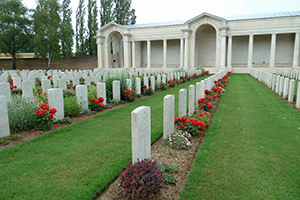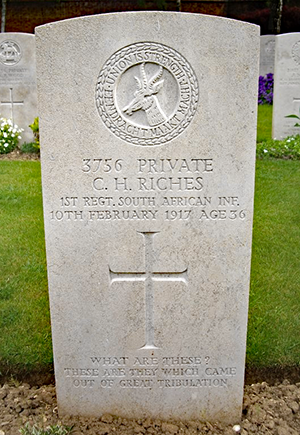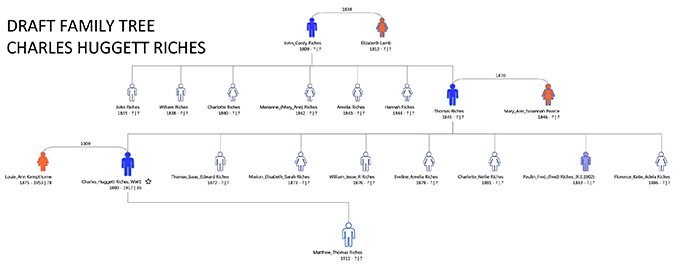First World War Project
Charles Huggett RICHES (of Teynham)
chr. 23rd June 1880 Private, Service Number 3756 |

 Charles' name is not included on the Teynham Memorial - this is an unfortunate omission. The Commonwealth War Graves Commission (CWGC) makes the following link with Teynham - "Son of Thomas and Mary Ann Riches, of Teynham, Kent; husband of Louie Ann Riches, of 55, Edith Rd., Ramsgate, England." However, this statement needs unpacking to understand his links with Teynham Parish - and point to possible reasons why his name has been lost to Teynham Remembrance. Despite this post-war omission, we believe the story of Charles Huggett Riches should be included in our Remembrances for Teynham Parish. Certainly, the local newspapers' Rolls of Honour recorded Charles as a "Teynham Man". His father, Thomas, was for many years the Stationmaster at Teynham and only latterly, the Stationmaster at Ramsgate. He then retired on a pension in Ramsgate. So far as we can determine, Thomas never again lived in Teynham. By the time of the 1926 Gazetteer, the family name has no local presence.
Charles' name is not included on the Teynham Memorial - this is an unfortunate omission. The Commonwealth War Graves Commission (CWGC) makes the following link with Teynham - "Son of Thomas and Mary Ann Riches, of Teynham, Kent; husband of Louie Ann Riches, of 55, Edith Rd., Ramsgate, England." However, this statement needs unpacking to understand his links with Teynham Parish - and point to possible reasons why his name has been lost to Teynham Remembrance. Despite this post-war omission, we believe the story of Charles Huggett Riches should be included in our Remembrances for Teynham Parish. Certainly, the local newspapers' Rolls of Honour recorded Charles as a "Teynham Man". His father, Thomas, was for many years the Stationmaster at Teynham and only latterly, the Stationmaster at Ramsgate. He then retired on a pension in Ramsgate. So far as we can determine, Thomas never again lived in Teynham. By the time of the 1926 Gazetteer, the family name has no local presence.
Charles was one of eight children raised by Thomas Riches and his wife, Mary Ann Susannah (née Pearce). His elder siblings were: Thomas Isaac Edward, Marion Elizabeth Sarah, William Jesse Robert and Eveline Amelia. The last of whom was born in Teynham, as was Charles and his three younger siblings, Charlotte Nellie, Paulin Frederick (Fred) and Florence Katie Adela. We have found military records for his younger brother, William, who served in the Royal Engineers before war broke out and is described more fully at the end of this page.
Charles Riches emigrated to South Africa. Emigration documents show he first travelled out from London, destined for Cape Town aboard the S.S. Norman leaving on 20th July 1907. His profession was given as "clerk". He married on 16th December 1909 to Louie Anne Kempthorne (34 years old) in the Cathedral at Cape Town. At the time of her marriage, her address was given as Burn's Hotel, Greenpoint. His wife, Louie, first emigrated to Cape Town with her sister, Jessie, boarding the "S.S. Salamis" from Portsmouth on 17th April 1907. These two sisters travelled with their married sister, Mrs Frances M. Annear.
It appears that Charles returned to England early in 1914 as his name appears, on 12th April 1914, departing from London aboard the "S.S. Briton" bound for the Cape. Then, on 22nd July 1914, Louie boarded the "Garth Castle", destined for London with husband, Charles and young son Matthew Thomas Riches. If we take the lead offered by the East Kent Gazette Obituary (below), Charles returned to South Africa to enlisted into 1st Battalion, South Africa Infantry. In the meantime, it appears that Louie and her son went to live with her married brother, Frederick, at 2-Dereham-terrace, Truro. Frederick was a clerk in Truro education department who died in 1921. It is not unreasonable to assume she felt most comfortable in the place her family lived while her husband was at the Front. The Probate document [dated 13th October 1917] for Charles reveals: "RICHES Charles Huggett of 2 Dereham-terrace TRURO private first South African infantry died 10 February 1917 in France Administration (with Will) BODMIN 13th October to Louie Ann Riches widow. Effects £298 4s." While these facts shed some doubt on Louie living in Ramsgate; however, the additions to Charles's headstone are credited to Louie with the given address in Ramsgate. Perhaps for a short while she did live with her in-laws? Alternatively, the parents submitted the wording on her behalf? Whatever the sequence, Charles's CWGC headstone carries the additional words, drawn from Revelation 7:14, "THESE ARE THEY WHICH CAME OUT OF GREAT TRIBULATION" - pointing to the final judgement and redemption of those admitted to Heaven. Louie died in 1953, at the age of 78 in a Merton Park (London) Nursing Home.
| East Kent Gazette of 10th March 1917 |
| TEYNHAM – KILLED IN ACTION. The death is reported in France, of Private Charles Huggett Riches, the third son of Mr. and Mrs T. Riches, of Ramsgate. Mr. T. Riches was formerly station master at Teynham, where the deceased young man was also well known. He left Teynham some years ago for an appointment in the revenue accountant's office of the South African railways, at Cape Town. When war broke out. Mr. Charles Riches volunteered twice for service before he was liberated. He came to England with the South African Forces in November, 1915, and proceeded to France last May. Private Riches was wounded in the lungs by shrapnel on February 10th, and died the same night at the field dressing station. The deceased, who was 33, leaves a widow and one child. |
Update: Until December 2025, our website declared - "We have not found British nor South African Memorials for him - only the CWGC headstone in France." This has now changed with grateful thanks to the researches of a visitor to our website:
| Correspondence |
| "I am presently working on the WW1 SAR&H Memorial, Main Railway Station, Kingsmead, Durban, Natal Province, South Africa, and his name is recorded thereon. Unfortunately this particular memorial is in pretty bad shape. It was originally, I think, in the old Durban Railway Station OR the Old Railway Members Club and moved to its present site in 1983/4. It consisted of 9 panels, 4 of which have 'disappeared', while the remaining 5 central panels are faded/watermarked behind a glass-fronted wood based surface. I estimate the 5 panels record about 430 names; and, as a rough guess, an additional 330 names from the missing panels. Therefore about 760 names were recorded The Memorial is on the south side of the main concourse, high up on the wall and needs a lot of attention. SAR&H stands for the old South African Railways and Harbours which had its origins in the old Union Railways. Bye the way, Durban was the first town in South Africa to establish a railway line of approx 3.2kms, running from the point area to the central market square and opened on the 26 June 1860 (Natal Government Railway Company). Private Charles Huggett Riches' name is definitely recorded on this Memorial." |
Charles' Effects went to his widow - Louie Ann - as sole legatee made up of £8 18s 4d plus War Gratuity of £6. There was a further entry - "a further sum is payable to this estate by the High Commissioner for the Union of South Africa, 32 Victoria St., estimated S.W. in respect of difference between Union and Imperial rates of militaty pay for service prior to 1st January 1917." [See Appendix 2]
Charles was posthumously awarded the British War and Victory Medals. [See Appendix 1]
Military Records
The South African authorities have not digitised the records for S.A.I. casualties, so we must look to his Obituary to learn when Charles first landed in England [November, 1915] and then to serve in France from May, 1916. Calculations based on the War Gratuity of £6 give an estimated enlistment of January 1915 - within the margin of error for this rough calculation. When he died in the field dressing station, he was buried alongside the final sixty men from the South African Infantry who were buried in Faubourg D'Amiens Cemetery, Arras.
Circumstances of the Death of Private Charles Huggett Riches
Arriving in France during May 1916, places Charles in the thick of The Battles of the Somme (Battle of Albert - 1st July 1916; Capture of Bernafay Wood - 3rd July; and Battles of Bazentin Ridge/Attack of Longueval - 14th July; Battle of Delville Wood - 15th July;). Moving onwards in time at the Somme, the 1st South African Infantry Brigade took part in the Battle of Transloy Ridges - 10th October 1916 and Attacks on The Butte De Warlencourt - 12th October.
There was a lull in fighting ahead of the Battle of Arras, which opened two months after Charles died of wounds inflicted by schrapnel fragments that penetrated his lungs.
Nevertheless, Charles and his comrades were at the Arras Frontline To understand the circumstances of his death we turn to the War Diary for the 1st Battalion of the South African Infantry Brigade through the early part of 1917. During November 1916, the Battalion was stationed at DUISANS to reorganise and receive extensive training (including significant attention to Lewis Gun training, bayonette drill, respirator drill and bombing practice) ahead of their move to the Front line at ARRAS. There was time for sport. This period of relatively peaceful activity for Charles ended on 3rd December 1916 when he and his comrades took over the Front Line ARRAS from the 16th Battalion, Cheshire Regiment.
Perhaps conscious that changes had taken place, the enemy lauched their aeroplanes and fired their trench mortars - relief operations were always full of jeopardy. However, there followed several quiet days that ended with active trench mortars from 10th December, aerial torpedoes, and artillery attacks on support trenches.There also followed some artillery duels, with little effect. The trenches were more damaged by the foul weather of 13th December. This pattern of mutual trench mortar attacks and artillery shells continued over the following days interspersed with lulls in hostilities. It wasn't until 23rd December that they were relieved out of the front line trenches by the 4th South African Infantry and moved to billets in ARRAS. In this period they supplied Working Parties to work on trenches.
When they returned to the trenches in the New Year, the pattern of trench warfare continued unabated. Again, on the 23rd of the month, the 1st S.A. returned to billets in ARRAS from which Working Parties were provided daily. There were few casualties during this period, but some losses through injury were experienced.
The February Diary read:
"1st February: 8.30pm: Relieved 4th South African Infantry in front line. Quiet day.
2nd February: Quiet day. Hostile Trench Mortars fairly acttive during afternoon.
3rd February: Hostile field artillery active during the day. Our Heavy Trench Mortars active in afternoon.
4th February: Enemy fired about ten 5.9 shells on our front line. Hostile Trench Mortars were active during the day.
5th February: Quiet day.
6th February: A few hostile Trench Mortars were fired on our lines.
7th February: Hostile Trench Mortars very active. Enemy aggressive. From the change of attitude a relief appears to have taken place.
8th February: Enemy Trench Mortars active. No Damage. Our artillery fired on "Minenwerfer" emplacements. Our Trench Mortars fired on PARROTS BEAK with good effect. No patrols out during the night.
9th February: Enemy Heavy Trench Mortars active. Enemy patrol dispersed during the night.
10th February: Hostile artillery active on Right Company's frontage. No damage done. Our Heavy Trench Mortar put out of action at 2 p.m. by 4.2 shell. Our artillery."
This last reference, "Our artillery", may indicate that this was 'friendly fire'. It is almost certainly the incident which inflicted the schrapnel injury to his lung. He died soon after.


 World War 1 Pages
World War 1 Pages